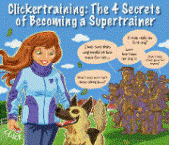Good Dog Training Advice
Get Fast & Simple Dog Training Tips to
Turn a Difficult Dog Into an Obedient Pet!
The Fundamentals of Dog Psychology and How They LearnThe number one problem I see in families that have dog problems is that they want to believe that their dog is a furry little person. They seem smart. They seem aware. They seem empathetic. And in some ways they are all three. But, underneath any clever looks and happy behaviours, your dog is a dog - bred to think like a dog and react naturally, the same as an animal would. This means they are built on instinct and rather than expecting them to change for us, we need to change for them. How a Dog Thinks Dogs think in terms of their instincts. That means they need to be fed, they need a place to sleep, and they
need a strong pack that will help keep them safe, which in turn means they need a strong pack leader who will guide
them and provide that protection. While a dog may eventually learn to respond to a command, they do not necessarily understand the word - not in
the same way that we do. Dogs are incapable of thinking in words, with the meaning attached to them. Rather, they
think in terms of many things. Learning to Think Like Your Dog What all of this means is that you need to learn how your dog thinks and then respond in turn. Your dog does not
think in terms of words and ideas. They think in actions and body language. The tone of your voice and the way you
hold yourself will always have a bigger impact than what you actually say. They will get excited and ready for your return. The day you don't return as expected - either
because of traffic or a late day at work - they will start to grow anxious as the scene replays in their mind. This
can lead to dog seperation anxiety.
| |
|


Discover the Secrets to Training Your Dog Or Puppy. Huge BONUSES for a limited time only!
Click here now...
|
http://GoodDogTrainingAdvice.com






